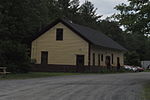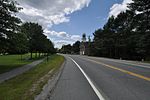Aloha Camp
1905 establishments in VermontBuildings and structures completed in 1905Buildings and structures in Fairlee, VermontHistoric districts on the National Register of Historic Places in VermontNRHP infobox with nocat ... and 5 more
National Register of Historic Places in Orange County, VermontQueen Anne architecture in VermontSummer camps in VermontTemporary populated places on the National Register of Historic PlacesUse mdy dates from August 2023

Aloha Camp is a summer camp for girls on Lake Morey in Fairlee, Vermont. Founded in 1905, it is the oldest girls' camp in the state. Open to children aged 12 to 17, it offers outdoor activities, arts and nature programs, and wilderness camping opportunities. The camp season is divided into two sessions of 3-1/2 weeks, running from late June to mid-August. The camp property is listed on the National Register of Historic Places.
Excerpt from the Wikipedia article Aloha Camp (License: CC BY-SA 3.0, Authors, Images).Aloha Camp
Lake Morey Road,
Geographical coordinates (GPS) Address Nearby Places Show on map
Geographical coordinates (GPS)
| Latitude | Longitude |
|---|---|
| N 43.928055555556 ° | E -72.155 ° |
Address
Lake Morey Road 2068
05045
Vermont, United States
Open on Google Maps








